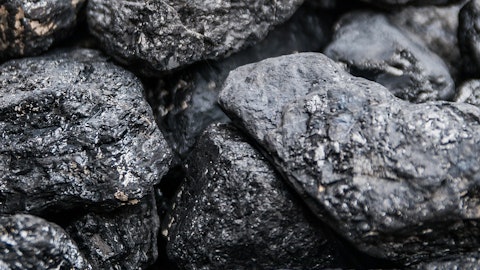That’s how we met Bill Smith, who had 35 years at Lilly, running chromatography facilities and building them to them. Now, he is on our team, is our Director of Engineering, which is I mean we are standing on the shoulders of giants with regards to our technologies. The feedstock, yes, the feedstock is probably the €“ I will say, on the refining side, there is batteries are starting to come to end of life. On the ores, we are starting to see a tremendous amount of progress there, which we are going to some very resource rich nations that we can talk about here shortly, hopefully, which we are progressing very nicely. Magnet side, we are working with one of the largest windmill manufacturers in the world that is now delivering us magnets, and we have another call with them in the next week to discuss the amount of magnets they supplying through there, working with the wind farms and stuff of that nature.
But the feedstocks are still building. It’s on the rear earth side, it’s an education telling people, what’s throwing them away, because we can recycle them. And then two, we have developed an innovative way to break them down. I can recycle a hard drive cost effectively now, which are small magnets. But our process that we developed internally to be able to process those magnets really cost effectively is a game changer. Actually the idea came by Jay Campbell, who works for us. Alongside, Jeff Peterson, who is absolutely just very smart guys thinking logically and how to do this. But that’s, developing those feedstocks comes into developing innovative ways to be able to processes feedstocks and cost effectively process those feedstocks. So, I would say feedstocks is probably across the industry as a whole.
It’s probably the biggest bottleneck. But once you get to the black mass, then there is nobody else is doing what we are doing, the ability to process and refine locally. In the United States that does not exist, everybody else is trying to build hydromet. I don’t think it’s going to be able to operate profitably. And I think they are going to have a tremendous time, tremendously difficult time trying to keep it in compliance, post operating, but alone the energy and chemical costs associated with it.
Tom Sauve: I can jump in here to an add some color, Kyle. As regards to feedstock, yes, it’s probably the biggest bottleneck. Especially on the recycling side is more batteries become closer to end of life, or get the end of life. Obviously, with the adoption of EV and other technologies, those supply sources will grow. But the flexibility of our technology allows us to navigate through those bottlenecks of feedstock supply. And that’s why we have not pivoted, but looked at natural occurring sources of lithium in spodumene ore that come from the African continent, because they today are producing lithium spodumene. They are exporting it to China in a raw form to be processed. Getting our hands on those types of feedstocks today is key for us.
Currently, there is a lot of lithium projects being explored and developed in the United States. And there is also need for permit reform. I think everybody can understand that here. But to get a mine up and running here in the United States takes somewhere between 10 years and 15 years, just given all the regulatory constraints that we that here in the United States. And those are good from an environmental standpoint, and labor standpoint and everything like that. And that’s why our technology, the flexibility of our technology fits really well within and solves those constraints in the supply chain, because we can navigate it, we can co locate abroad where we can add value of producing purified resources, as well as growing congruently with the market on the recycling side, where we don’t have to make massive CapEx that hope that the supplies €“ those feedstock supplies pick up, or if there is a big chasm there between deploying that capacity and not having the feedstocks to feed it, which is going to €“ which we think will probably cause a problem in the recycling space as other refining methods attempt to be deployed, if that makes sense.




